Time Time
 A juggler keeps
n
balls going with one hand, so that at any instant,
n
−
1
balls are in air and one ball is in his hand. If each ball arises to a height of
x
meters, which of the following represents the time that each ball stays in his hand?
A juggler keeps
n
balls going with one hand, so that at any instant,
n
−
1
balls are in air and one ball is in his hand. If each ball arises to a height of
x
meters, which of the following represents the time that each ball stays in his hand?
This section requires Javascript.
You are seeing this because something didn't load right. We suggest you, (a) try
refreshing the page, (b) enabling javascript if it is disabled on your browser and,
finally, (c)
loading the
non-javascript version of this page
. We're sorry about the hassle.
2 solutions
can you please explain how the eqn for time was obtained?
Log in to reply
Because the maximum height, relative to the hand, is given by x, this means the time the ball needs to fall from the highest point is given by g 2 x . The time up is the same so, double it.
I wonder how the time interval while the ball falls down equals the time interval while coming up. Because when you throw the ball up, you must give in some velocity to the ball, the ball must reach to another higher position before stop moving up and fall down. Is that we have to make an assumption that the juggler has to maintain in somehow for the ball to only reach a specific x height?
isnt a person having two hands. so it should be divided by 2....
The time taken by one ball to leave juggler's hand and come back is given by t = 2 g 2 x . Now in this time the juggler has thrown another n − 1 balls. So the time for which one ball stayed in his hand is T = n − 1 2 g 2 x .
Yeah the answer is wrong
I have updated the answer to n − 1 2 g 2 x .
Log in to reply
Sir as u can see that i have given the correct explanation for the answer. Why is it showing me that i selected the wrong answer?
During the time interval of 2 g 2 x the juggler has to throw n balls, not n-1 balls.
Log in to reply
Yes, the wording is a bit ambiguous.... a better way to explain is that at time Δt the juggler has held n-1 balls in total for time t1 each ..... so t1 = Δt/(n-1)
This is my first problem and solution so i heartily ask for any inconvenience or mistake.
Log in to reply
The two outside is total time =time of ascent + time of desent and since acent desent time is equal that why two is multiplied
Please correct the answer..... it says your solution is wrong..(while its correct) :)
where did you get the 2 on the outside of the square root?
Log in to reply
The square root is the time to go up. We need to find the total time to go up and then then down so we multiply by two (because the time to go up is equal to the time to go down ) :)
For those who are wondering where the T = g 2 x came from, here is the derivation.
We start out with the simple equation for (vertical for our purposes) the acceleration near the surface of the earth for a point mass.
a ( t ) = − g
Then we integrate that twice to get the linear displacement function. Remember the initial conditions are, generally, v ( 0 ) = v 0 and d ( 0 ) = d 0 .
d ( t ) = ∫ ( ∫ a ( t ) d t ) d t = 2 − g t 2 + v 0 t + d 0
Where v 0 is the initial velocity, and d 0 is the initial displacement.
Now in the case of the point mass merely dropping off a certain height x and reaching ground level ( d ( t ) = 0 ), we reduce the equation to.
d ( t ) = 0 = 2 − g t 2 + ( 0 ) t + x
Now if we just move the x to the left side, put the 2 and the g on the left side in their proper places, and then square root the whole thing, we get
t = g 2 x
Which is the time taken for the point mass to fall from a certain height x and reach 'ground' level.
Simple is using the 2nd law of motion, Without using the derivatives to show that T=..... H=ut+1/2gt sq. U=0m/s,t=sq. Root of 2H/g Here, x=H Hence the required solution.
The time t necessary for one ball to go up and down is given by :
t = 2 . g 2 x .
For n = 2 (balls), this is also the time one ball stays in the hand of the juggler.
T = n − 1 2 . g 2 x is the only solution that gives the correct answer for n = 2.